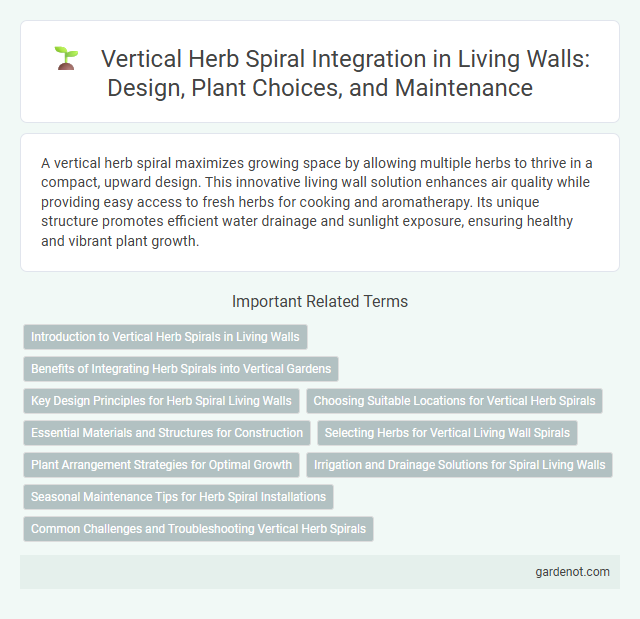A vertical herb spiral maximizes growing space by allowing multiple herbs to thrive in a compact, upward design. This innovative living wall solution enhances air quality while providing easy access to fresh herbs for cooking and aromatherapy. Its unique structure promotes efficient water drainage and sunlight exposure, ensuring healthy and vibrant plant growth.
Introduction to Vertical Herb Spirals in Living Walls
Vertical herb spirals in living walls maximize space by integrating spiraled plant arrangements that enhance microclimates for diverse herbs. These spirals improve vertical gardening efficiency by optimizing sunlight exposure and moisture retention for each herb layer. Incorporating a vertical herb spiral into a living wall supports sustainable urban agriculture and elevates aesthetic appeal.
Benefits of Integrating Herb Spirals into Vertical Gardens
Integrating herb spirals into vertical gardens maximizes space efficiency by creating a multi-level planting area ideal for diverse herb varieties, enhancing biodiversity. This design improves microclimates within the garden, optimizing water retention and sunlight exposure for healthier, more productive plants. Vertical herb spirals also facilitate easier harvesting and maintenance, making them perfect for urban gardening and sustainable living practices.
Key Design Principles for Herb Spiral Living Walls
Key design principles for a vertical herb spiral living wall emphasize maximizing space efficiency by stacking herbs in a spiraling structure, facilitating optimal sunlight exposure for each plant layer. Incorporating proper irrigation systems ensures consistent moisture distribution, while selecting herbs with complementary water and light needs enhances growth synergy. Structural stability and easy access for harvesting further define the functional and aesthetic success of herb spiral living walls.
Choosing Suitable Locations for Vertical Herb Spirals
Vertical herb spirals thrive in locations with ample sunlight, ideally receiving 6 to 8 hours of direct light daily to support diverse herb growth. Selecting well-drained soil environments or installing proper drainage systems prevents waterlogging, essential for healthy root development. Positioning the spiral near kitchen access or outdoor seating areas enhances convenience and aesthetic appeal in herb gardening.
Essential Materials and Structures for Construction
A vertical herb spiral requires essential materials like untreated wooden pallets or bricks for the base structure, breathable garden fabric for lining, and nutrient-rich soil combined with compost for planting. The spiral's design optimizes vertical space by stacking layers in a circular pattern, promoting efficient water drainage and sunlight exposure for each herb. Incorporating a central drainage pipe and securing materials with galvanized nails or screws ensures stability and longevity in diverse indoor or outdoor environments.
Selecting Herbs for Vertical Living Wall Spirals
Choosing herbs for vertical living wall spirals requires selecting varieties that thrive in compact, vertical environments with good drainage and airflow. Ideal herbs include thyme, basil, rosemary, and oregano, known for their adaptability to limited soil space and consistent light exposure. Prioritizing drought-tolerant and low-maintenance herbs ensures longevity and vibrant growth within vertical garden structures.
Plant Arrangement Strategies for Optimal Growth
Vertical herb spirals utilize strategic plant arrangement by positioning sun-loving herbs like rosemary and thyme at the top, while shade-tolerant plants such as mint and parsley occupy lower levels to maximize light exposure. This tiered configuration improves airflow and nutrient distribution, promoting healthy root development and reducing pest issues. Incorporating companion planting principles enhances growth synergy, resulting in a more productive and sustainable vertical garden.
Irrigation and Drainage Solutions for Spiral Living Walls
Vertical herb spirals incorporate integrated irrigation systems that deliver water directly to plant roots, enhancing water efficiency and plant health. Advanced drainage solutions prevent waterlogging by allowing excess moisture to flow through layered substrates, maintaining optimal soil aeration. These combined irrigation and drainage technologies ensure sustainable growth and minimize maintenance for spiral living walls.
Seasonal Maintenance Tips for Herb Spiral Installations
Seasonal maintenance for vertical herb spirals includes regular pruning to promote healthy growth and prevent overcrowding, especially in spring and summer. Winter protection involves insulating the base with mulch and using frost cloths to shield delicate herbs from cold temperatures. Consistent watering schedules should be adjusted seasonally to prevent root rot during rainy months and drought stress in dry periods.
Common Challenges and Troubleshooting Vertical Herb Spirals
Vertical herb spirals often face challenges such as uneven water distribution and soil compaction, which can inhibit plant growth and lead to root rot. Proper drainage systems and the use of lightweight, well-aerated soil mixtures are essential to prevent waterlogging and promote healthy root development. Regular monitoring for pest infestations and adjusting sunlight exposure can troubleshoot common issues and ensure a thriving vertical herb spiral.
Vertical herb spiral Infographic

 gardenot.com
gardenot.com